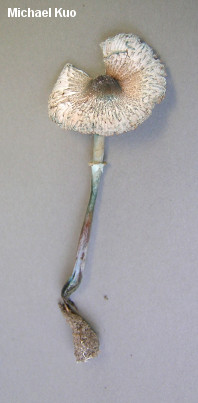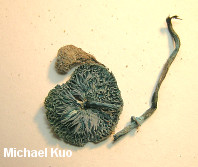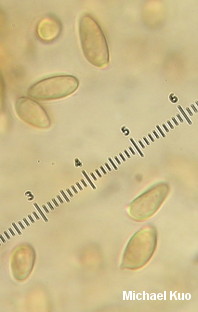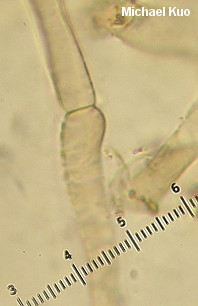| Major Groups > Gilled Mushrooms > Pale-Spored > Lepiotoid Mushrooms > Leucoagaricus caerulescens |

|
Leucoagaricus caerulescens [ Basidiomycota > Agaricales > Agaricaceae > Leucoagaricus . . . ] by Michael Kuo A few rare North American lepiotoid mushrooms demonstrate dramatic blue to green staining when handled or dried; among them, Leucoagaricus caerulescens is distinct in having white flesh and gills. Lepiota viridiflavoides, described from Florida, also bruises blue, but has yellow gills and flesh. The illustrated collection was made in Texas by mushroom expert Jay Justice. The little mushroom appeared to be one of a gazillion little lepiotoid species best sorted out with microscopic analysis, until it began to bruise pinkish and reddish. Then Jay and I watched in amazement as it began to turn blue--first on the stem, then the cap, and finally, when placed in a dryer, nearly overall. Lepiota virescens is a synonym. Leucoagaricus caerulescens was placed in Leucoagaricus by Liang and collaborators (2010) on the basis of morphological study of the type collection; it was formerly Lepiota caerulescens. Description: Ecology: Probably saprobic; originally described from Ohio (Peck, 1899), with precise ecology unspecified. The illustrated collection was made in October, in Texas, in mixed woods dominated by loblolly pine, willow oak, and sweetgum. Cap: 1-2 cm; at maturity planoconvex, with a shallow central bump; dry; smooth and dark brown over the center; elsewhere finely radially scaly with brown to reddish brown scales and fibers over a whitish ground color; the margin finely lined for about 5 mm; bruising pinkish, then blue. Gills: Free from the stem; close; short-gills frequent; white; bruising pinkish, then blue. Stem: Up to 6 cm long; up to 2 mm thick; more or less equal, with a small basal bulb; bald; whitish, bruising pinkish to reddish on handling, then turning blue; with a persistent but fragile, sheathing ring. Flesh: White. Odor and Taste: Odor not distinctive; taste not documented. Spore Print: Not documented; probably white. Dried Specimens: Becoming deep blue overall while drying, then fading to brownish over time in the herbarium. Microscopic Features: Spores 7-10 x 4-5 µ; more or less elliptical, but somewhat variable in shape (often inequilateral or slightly ovate); smooth; hyaline in KOH; faintly brownish in Melzer's. Cheilocystidia clavate to fat-cylindric; to about 30 x 10 µ; hyaline in KOH; thin-walled. Pileipellis of long, erect, septate units with cylindric to clavate terminal elements 6-12 µ wide; brownish in KOH; often finely encrusted. Clamp connections not found. REFERENCES: (Peck, 1899) Liang, Yang & Xu, 2010. (Saccardo, 1902; Morgan, 1906; Kauffman, 1924; Smith, Smith & Weber, 1979; Liang et al., 2010.) Herb. Kuo 10200707. This site contains no information about the edibility or toxicity of mushrooms. |
© MushroomExpert.Com |
|
Cite this page as: Kuo, M. (2015, October). Leucoagaricus caerulescens. Retrieved from the MushroomExpert.Com Web site: http://www.mushroomexpert.com/leucoagaricus_caerulescens.html |



